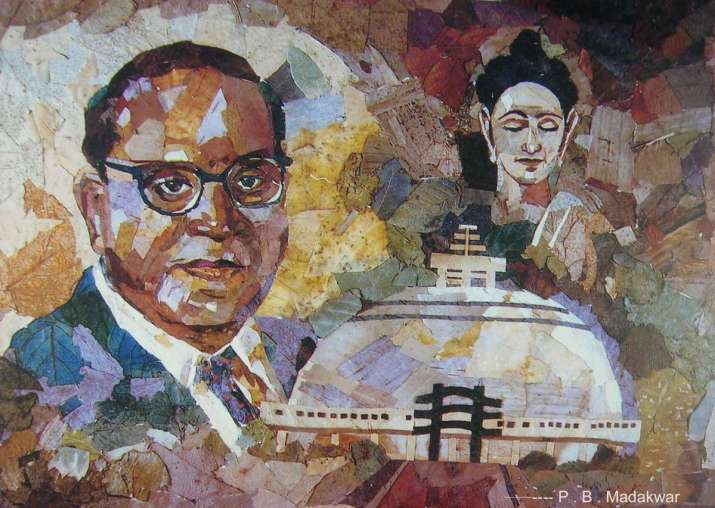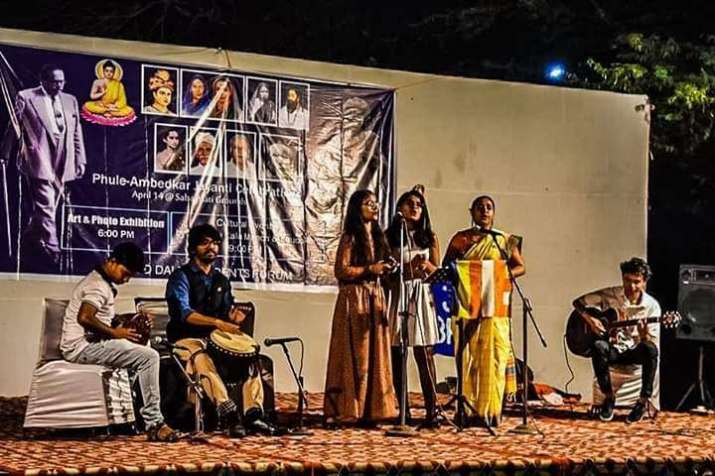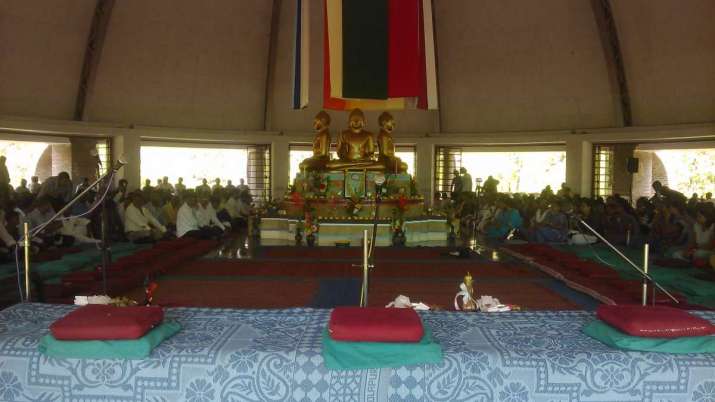FEATURES|THEMES|People and Personalities
An Ambedkarite Buddhist Today
 Painting by P. B. Madakwar, a young Buddhist, showing Dr. Ambedkar, the Buddha, and Deekshabhoomi (the place where the first mass conversion took place). Image courtesy of author
Painting by P. B. Madakwar, a young Buddhist, showing Dr. Ambedkar, the Buddha, and Deekshabhoomi (the place where the first mass conversion took place). Image courtesy of authorThe experience of being a Buddhist is always different, depending on time and context. Over the past 2,500 years, Buddhism has encountered different cultures, different contexts, and a variety of approaches. It is no surprise, therefore, that even today there are many different contexts and approaches existing alongside one another. Still it would be of delight to any Buddhist to know how the Dhamma has worked to emancipate millions from the prolonged domination of socio-religious caste oppression in India.
Let me begin with my own story. It is said that something taught to you as a child stays with you forever. As a child, I used to be really upset that we never celebrated the Hindu festivals Holi, Diwali, or Durga Puja at home. Instead, the festivals we observed were Dhamma-Chakkra-Pravarttan Day,* Vesak, and the birth anniversary of Dr. B. R. Ambedkar. I did not understand this as a child, but I do now. It was a struggle for every Buddhist family to follow in Dr. Ambedkar’s footsteps to be and remain Buddhist, and leave behind old Hindu beliefs and customs. This juxtaposing of Buddhism and Hinduism is specific to the Buddhist assertion in India as taught by Dr. Ambedkar to his followers: Buddhism is distinct from Hinduism, Buddhism is not a part of Hinduism, and the Buddha is not an avatar of Vishnu.
There still are many households in various parts of India who face casteism in everyday life. As for me, I feel privileged to have been born into a Buddhist family in the city of Nagpur, surrounded by people who understand Buddhism and Dr. Ambedkar. I was unaware of the word caste until one memorable day in class when I was in grade 5. Our teacher asked us to ask our parents what caste each of us belonged to. The next day, when teacher started collecting the answers, I realised I had completely forgotten to ask my mom. All of us were asked to stand up when our caste category was called out, Scheduled Tribes (ST),** Scheduled Castes (SC),*** Other Backward Classes (OBC),**** Open Category,***** and minorities, etc. I was absolutely clueless throughout this process. Finally, the teacher noticed that I hadn’t stood up for any of those categories, trying to help me figure it out, she asked what religion I belonged to? I happily told her that I was Buddhist.
She must have noted down my name in the SC category since almost all Buddhists in Maharashtra come from the Ambedkarite conversion movement and were “untouchables,” i.e. lower than the lowest. The lowest caste are Shudras, also known as OBCs.
 The Buddhist music band Baudhkaro performing at Jawaharlal Nehru University on the occasion of the 127th birth anniversary of Dr. Ambedkar. From Baudhkaro Twitter
The Buddhist music band Baudhkaro performing at Jawaharlal Nehru University on the occasion of the 127th birth anniversary of Dr. Ambedkar. From Baudhkaro TwitterVruttant, a PhD student from Jawaharlal Nehru University (JNU) in Delhi, talks proudly of his small basti or slum called Bhim-nagar in Kamptee near Nagpur. “People from our basti were mostly manual workers, rickshaw pullers, etc. Very few of them were educated but they understood Babasaheb [Dr. Ambedkar] like no other. They asserted themselves as Buddhists. If ever anybody called them a Dalit they would retort that they are not Dalit, but Buddhists.”
Conversion gave us a new identity. Today, I am aware that asserting my identity as a Buddhist is the first and foremost answer to a world that still wants to push us back into our old imposed identity. Dr. Ambedkar’s purpose for conversion was to emancipate the oppressed in society. His dream was to create a society based on the principle of liberty, equality, and fraternity, and he hadn’t taken these principles from the French Revolution but from Buddhism. This makes Buddhism a way toward emancipation. Being Buddhist empowers me to assert that I am equal to any other human being, that I am free, that I am capable of the highest achievement, i.e. Buddhahood. This gives me and my kind the power to throw off all the labels and forced beliefs that condemned my ancestors to a degraded identity.
The roots of the above-mentioned transformation lie in the 22 vows that Dr. Ambedkar gave to his disciples at the time of their conversion. They were a vitally important aspect of the conversion, working as a great transforming agent and guideline for his followers, rejecting old identity and beliefs, asserting a new identity, and commiting to a new way of life that starts from treating every human being as an equal, practicing the Five Precepts, the Noble Eightfold Path, and more. It is an essential aspect of the Dhamma to which Dr. Ambedkar wanted his people to adhere.
After Dr. Ambedkar’s death, just seven weeks after the great mass conversion, none of his disciples knew what Buddhism was, or how to practise or even belong to it. They did their best to cling to their new identity, along with chanting the Three jewels and Five Precepts. Bhikkhus here and there would give them chanting lessons. The first Marathi translation of Buddha and his Dhamma, written by Dr. Ambedkar, came in 1970. There was very little to quench the thirst for the Dhamma until the late 1970s and early 1980s, and yet the basics of Buddhism as laid out by Dr. Ambedkar in the conversion ceremony were enough to start the huge transformation our community underwent in the first 20 years.
 The shrine at the Hsuen Tsang retreat centre in Bordharan, Wardha, Maharashtra. Image courtesy of author
The shrine at the Hsuen Tsang retreat centre in Bordharan, Wardha, Maharashtra. Image courtesy of authorIn 1978, Ven. Sangharakshita sent his young disciples to India to begin the work of the Triratna Buddhist Community. It is the only large sangha that is teaching the Dhamma and addressing the concerns of followers of Dr. Ambedkar throughout the nation. Presently, there are some 80–90 million Buddhists who have converted with and after Dr. Ambedkar. They are eager to learn and practice, so we need more teachers to help them understand and follow the Dhamma.
My parents have been a part of the Triratna Buddhist Community since they were in their late teens and have dedicated their lives to the path laid out by the Buddha and Dr. Ambedkar. This is the very reason behind my Buddhist upbringing. I grew up among people who were Buddhists, regardless of gender, caste, or race. I met all kinds of Buddhists—people coming from different states of India, from Europe, and from Asian countries too. I started identifying with the international Buddhist community, hence I represent a generation of my community far removed from the confinements of Ambedkarite Buddhists just two generations ago.
My friend Ritesh, who is from a small village in Bihar, told me, “My father is a farm labourer. He works very hard every day, but when the time comes for him to ask for his wage he still feels scared of the landlord, who is a Rajput (a higher caste). I try to explain to him that he should not be scared because discrimination on the basis of caste is constitutionally unlawful, but he fears not only the landlord but betraying the Hindu religion as well. I feel glad to have found the sangha for it gives me the courage and knowledge to educate my family and a hope for a better life.”
Ritesh, who is 19, is currently a Buddhist trainee at the Hsuen Tsang Retreat Centre in Bordharan, Maharashtra, and wishes to pursue higher studies as well.
Caste atrocities are still going on, unfortunately, but awareness and resistance is growing, and the number of people asserting themselves as Buddhists is increasing. Indian Buddhist organizations have begun joining hands with other Buddhists outside of India because it is not possible to achieve Babasaheb’s dream of “Prabuddha Bharat,” without their help.
In the course of writing this article, I talked with few of my Buddhist friends. I was really pleased to learn that they all feel hopeful about the rise of Buddhism in India. Someday India will again see days like those seen under the reign of Buddhist emperor Ashoka. With a heart full of hope, I look forward to that time.
* Dhamma-Chakkra-Pravartan Day (the day of the revolution of the Dhamma wheel) is the day that Dr. Ambedkar converted to Buddhism with thousands of his followers.
** Scheduled Tribe is the official name for indigenous people regarded as socially and economically disadvantaged.
*** Scheduled Caste is the official name given to people regarded by the orthodox Hindu scriptures as untouchables.
**** Other Backward Class (OBC) is the name given to people previously regarded by the orthodox Hindu scriptures as Shudras.
***** Open Category or forward caste is the official name given to upper caste people, including Brahmins.
Related features from Buddhistdoor Global
A New Birth: Walking on the Path of Buddhism
Being Buddhist in India Today: Seizing Mount Sumeru in the Latter Day of the Law
A Light in the Darkness of the Slums of India
Living Dr. Ambedkar’s Vision
Related news from Buddhistdoor Global
Anniversary of B. R. Ambedkar's Death Prompts Marches and Reflection
Dalai Lama Lauds Hindu Priest’s Gesture of Equality for Bearing Dalit Man into Temple
Ten Thousand Dalits Reportedly Embrace Buddhism During Dussehra Festival
Data Shows Improved Literacy Rates, Gender Equality Among Buddhist Converts in India














